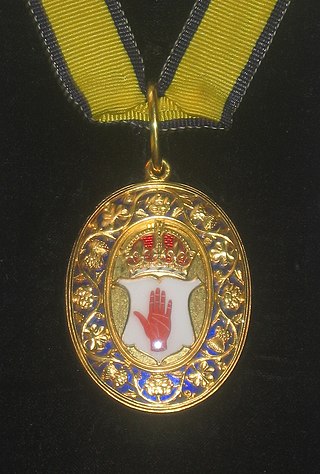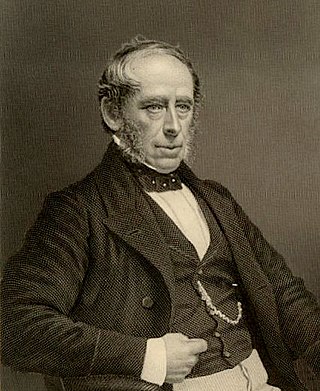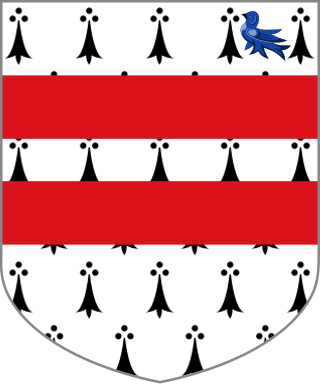
A baronet or the female equivalent, a baronetess, is the holder of a baronetcy, a hereditary title awarded by the British Crown. The title of baronet is mentioned as early as the 14th century; however, in its current usage it was created by James I of England in 1611 as a means of raising funds for the crown.

Viscount Cobham is a title in the Peerage of Great Britain that was created in 1718. Owing to its special remainder, the title has passed through several families. Since 1889, it has been held by members of the Lyttelton family.

Baron Farnham, of Farnham in the County of Cavan, is a title in the Peerage of Ireland. It was created in 1756 for John Maxwell, who had previously represented Cavan Borough in the Irish House of Commons. John Maxwell's son, the second Baron, was created Viscount Farnham in 1760 and Earl of Farnham in 1763. Both titles were in the Peerage of Ireland but became extinct when he died childless in 1779. His brother and successor, the third Baron, was again created Viscount Farnham in 1781 and Earl of Farnham in 1785. These titles were also in the Peerage of Ireland. His son, the second Earl, sat in the House of Lords as an Irish representative peer from 1816 to 1823. However, he had no children and on his death in 1823 the viscountcy and earldom became extinct.

Baron Hampton, of Hampton Lovett and of Westwood in the County of Worcester, is a title in the Peerage of the United Kingdom. It was created in 1874 for the Conservative politician Sir John Pakington, 1st Baronet.

Baron St Levan, of St Michael's Mount in the County of Cornwall, is a title in the Peerage of the United Kingdom. It was created on 4 July 1887 for the former Member of Parliament Sir John St Aubyn, 2nd Baronet, becoming John St Aubyn, 1st Baron St Levan. He had previously represented Cornwall West in House of Commons as a Liberal and St Ives as a Liberal Unionist. He was succeeded by his eldest son, the second Baron, who was a Colonel and Honorary Brigadier-General in the Grenadier Guards. On his death the titles passed to his nephew, the third Baron, the son of the Hon. Sir Arthur James Dudley Stuart St Aubyn (1867–1897), second son of the first Baron. The third baron was succeeded in 1978 by his eldest son, the fourth baron, who had served with the Royal Navy at Dunkirk and in a minesweeper in Arctic Convoys during World War II and was awarded the Distinguished Service Cross (DSC). As of 2014, the titles are held by the fourth Baron's nephew, the fifth Baron, who succeeded in 2013.

Baron Dufferin and Claneboye, of Ballyleidy and Killyleagh in County Down, Northern Ireland, is a title in the Peerage of Ireland. It was created on 30 July 1800 for Dame Dorcas Blackwood, widow of Sir John Blackwood, 2nd Baronet, Member of the Irish Parliament for Killyleagh and Bangor, in return for support for the Union of Ireland and the United Kingdom.

Sir George Nugent, 1st Baronet, GCB was a British Army officer. After serving as a junior officer in the American Revolutionary War, he fought with the Coldstream Guards under the Duke of York during the Flanders Campaign. He then commanded the Buckinghamshire Volunteers in the actions of St. Andria and Thuyl on the river Waal and participated in the disastrous retreat from the Rhine. He went on to be commander of the northern district of Ireland, in which post he played an important part in placating the people of Belfast during the Irish Rebellion, and then became Adjutant-General in Ireland. He went on to be Governor of Jamaica, commander of the Western District in England, commander of the Kent District in England and finally Commander-in-Chief, India.

There have been nine baronetcies held by people with the surname Nugent, four in the Baronetage of Ireland and five in the Baronetage of the United Kingdom. Six of the creations are extinct, while three are extant.
There have been three baronetcies created for persons with the surname O'Neill, two in the Baronetage of Ireland and one in the Baronetage of the United Kingdom.
There have been three baronetcies created for persons with the surname Everard, one in the Baronetage of Ireland, one in the Baronetage of England and one in the Baronetage of the United Kingdom. Only one creation is extant as of 2010.
There have been four baronetcies created for persons with the surname Musgrave, one in the Baronetage of England, one in the Baronetage of Nova Scotia, one in the Baronetage of Ireland and one in the Baronetage of the United Kingdom. As of 2014 two of the creations are extant.
There have been three baronetcies created for persons with the surname Osborne, two in the baronetage of England and one in the baronetage of Ireland. Two creations are extant.
Sir Percy Fitzgerald Nugent, 1st Baronet, was an Irish politician.

Sir Walter Richard Nugent, 4th Baronet was an Irish baronet, politician and member of parliament (MP) in the House of Commons from 1907 to 1918.
The High Sheriff of Westmeath was the British Crown's judicial representative in County Westmeath, Ireland from its creation under The Counties of Meath and Westmeath Act 1543 until 1922, when the office was abolished in the new Free State and replaced by the office of Westmeath County Sheriff. The sheriff had judicial, electoral, ceremonial and administrative functions and executed High Court Writs. In 1908, an Order in Council made the Lord-Lieutenant the Sovereign's prime representative in a county and reduced the High Sheriff's precedence. However the sheriff retained his responsibilities for the preservation of law and order in the county. The usual procedure for appointing the sheriff from 1660 onwards was that three persons were nominated at the beginning of each year from the county and the Lord Lieutenant then appointed his choice as High Sheriff for the remainder of the year. Often the other nominees were appointed as under-sheriffs. Sometimes a sheriff did not fulfil his entire term through death or other event and another sheriff was then appointed for the remainder of the year. The dates given hereunder are the dates of appointment. The following is an incomplete list: all addresses are in County Westmeath unless stated otherwise.
The High Sheriff of Longford was the British Crown's judicial representative in County Longford, Ireland from the 16th century until 1922, when the office was abolished in the new Free State and replaced by the office of Longford County Sheriff. The sheriff had judicial, electoral, ceremonial and administrative functions and executed High Court Writs. In 1908, an Order in Council made the Lord-Lieutenant the Sovereign's prime representative in a county and reduced the High Sheriff's precedence. However the sheriff retained his responsibilities for the preservation of law and order in the county. The usual procedure for appointing the sheriff from 1660 onwards was that three persons were nominated at the beginning of each year from the county and the Lord Lieutenant then appointed his choice as High Sheriff for the remainder of the year. Often the other nominees were appointed as under-sheriffs. Sometimes a sheriff did not fulfil his entire term through death or other event and another sheriff was then appointed for the remainder of the year. The dates given hereunder are the dates of appointment. All addresses are in County Longford unless stated otherwise.
There have been three baronetcies created for persons with the surname Humble, two in the Baronetage of England and one in the Baronetage of the United Kingdom. All are extinct.
Sir William Talbot, 3rd BaronetPC (Ire) was the last of the Talbot baronets of Carton: his title was forfeited on account of his loyalty to King James II of England. He was an Irish politician and judge, who served briefly as Master of the Rolls in Ireland.

The O'Reilly, later Nugent baronetcy, of Ballinlough in the County of Westmeath, was created in the Baronetage of Ireland on 23 July 1795 for Hugh O'Reilly. In 1812, on the death of his maternal uncle John Nugent, he assumed by Royal licence the surname of Nugent. The third Baronet was Chamberlain to the Emperor of Austria and was also created a Count of the Austrian Empire. The family seat is Ballinlough Castle, Clonmellon, County Westmeath.

The Nugent baronetcy, of Donore in the County of Westmeath, was created in the Baronetage of the United Kingdom on 30 September 1831 for Percy Nugent, a collateral descendant of the holders of the first creation in 1768.









